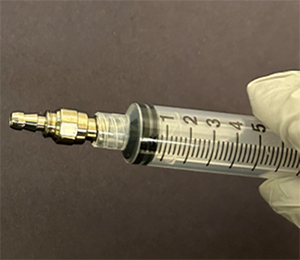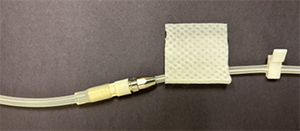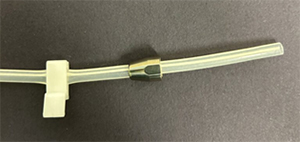Titanium Adapter Change for Home Peritoneal Dialysis Patients
Important information for catheter procedures (PD patients):
Understanding procedures
-
Know when and how to perform each procedure, especially after contamination.
-
Pay attention if the clamps are open or if dialysis is happening during contamination. If so, antibiotics may be needed—your dialysis team will confirm.
-
Contact your dialysis team to know which procedure is required.
Definitions
Touch contamination
-
Touch contamination happens when a sterile item (transfer set, catheter, or mini cap) touches something non-sterile, like your hands.
-
This increases the risk of peritonitis.
-
Be sure to know which cycler supplies are sterile.
Transfer set change
Titanium adapter change
You'll get emergency procedure supply bags when starting home PD. Keep these bags stocked and in an easy-to-find place at home. Check expiration dates and let your dialysis center know when supplies need updating.
Instructions for titanium adapter change:
-
Before starting place beta cap clamp on PD catheter tubing above the hole or split (closer to the patient) while preparing for procedure.
-
You may need a second set of hands to help with this procedure.
Prepare for the procedure
-
Wash your hands before touching any of your supplies:
-
Turn on the water.
-
Wet your hands and wrists.
-
Use liquid soap from a pump dispenser. Work up a lather.
-
Scrub your hands thoroughly for at least 20 seconds.
-
Rinse your hands, keeping your fingers pointed downward toward the drain.
-
Dry your hands with a clean paper towel. Use this paper towel to turn off the faucet.
-
Once you have washed your hands, be careful only to touch your supplies. You must wash your hands again if you touch anything else, such as furniture or your clothes.
-
If you prefer, clean your hands using an alcohol-based hand sanitizer.
-
Gather supplies. Check expiration dates of supplies prior to using.
-
Sterile syringe
-
Alcohol pads
-
Sterile gloves
-
Sterile scissors
-
Locking titanium adapter
-
Minicap™
-
New transfer set
-
Masks
-
Clean exam gloves
-
Clean your work area
-
Keep pets and other children out of your work area.
-
Don't work in the bathroom. There are too many germs.
-
Clean washable surfaces with soap and water. Dry with a paper towel.
-
Wipe down non-washable surfaces (such as fabric or wood) to remove dust.
-
Spread a clean cloth, paper towel or blue chuck over your work surface.
-
Place your supplies on the clean, dry, covered work surface.
-
Put on a mask and wash your hands again, using step 1 above.
-
If you feel the need to sneeze or cough, turn away from your work surface.
Perform procedure
-
Open your sterile gloves and carefully drop the syringe, alcohol pad, sterile scissors, titanium adapter, and locking cap on top of the sterile gloves, using this as your sterile field and maintaining sterility of all items
-
Follow sterile glove technique to prepare for this procedure
-
Once sterile gloves are on, to maintain the sterility of the titanium adapter, attach the sterile syringe to the luer lock end of the titanium adapter as seen below.
|

|
|
Titanium adapter (luer lock). Keep syringe and adapter on sterile field until needed in step 7
|
-
Take the alcohol pad and wipe the area on the PD catheter between the titanium adapter and the Beta-Cap clamp for 15 seconds and let dry.
|

|
|
Alcohol pad on the PD catheter, between clamp and adapter.
|
-
Using the sterile scissors, identify the area on the PD catheter and cut PD catheter at this area; do not let go of the end of the catheter.
-
Always cut the catheter as far away from the patient and the exit site of the catheter as possible.
-
Above the cut or split but as close as possible to the cut or split.
-
Cutting the catheter too closely to the exit site of the catheter may cause problems such as catheter dislodgement or peritonitis.
-
Pick up the locking cap from the sterile field and pass the catheter through the small end. The threads on the locking cap should be facing away from the child towards the end of the catheter.
|

|
|
Locking cap
|
-
Pick up the titanium adapter with the sterile syringe attached and feed the catheter onto the end of the titanium adapter up to the threads on the adapter. Ensure the end of the titanium adapter is fully in the catheter.
-
Once the catheter is completely on the end of the adapter, join the locking cap and the titanium adapter together.
-
Hold the adapter and syringe; turn the locking cap until it completely meets the adapter
-
After tightening, gently pull on the catheter to confirm that it is securely connected to the titanium adapter.
-
Adapter should not disconnect from the catheter; if it does disconnect, repeat the procedure.
-
Open the new MiniCap, set aside.
-
Carefully remove the new transfer set from the package, remove the blue pull ring from the end of the new transfer set. While holding the new transfer set in one hand, remove the sterile syringe from the titanium adapter with the other. Be careful not to contaminate or touch the end of the transfer set.
-
Attach the new transfer set to the titanium adapter by twisting it on to the titanium adapter, make sure it is tight.
-
Close the white twist clamp on the transfer set.
-
Remove the clear cap on the end of the new transfer set and replace it with a new MiniCap.
Contact your CHOP dialysis team with questions or concerns.
-
8:30 a.m.-4:30 p.m., Monday-Friday call 215-590-2449.
-
Outside of those hours, and on holidays, call 215-590-1000, ask the hospital operator for the nephrology fellow or PD dialysis RN.
Reviewed December 2024 by Rebecca Deady BSN, RN, CDN